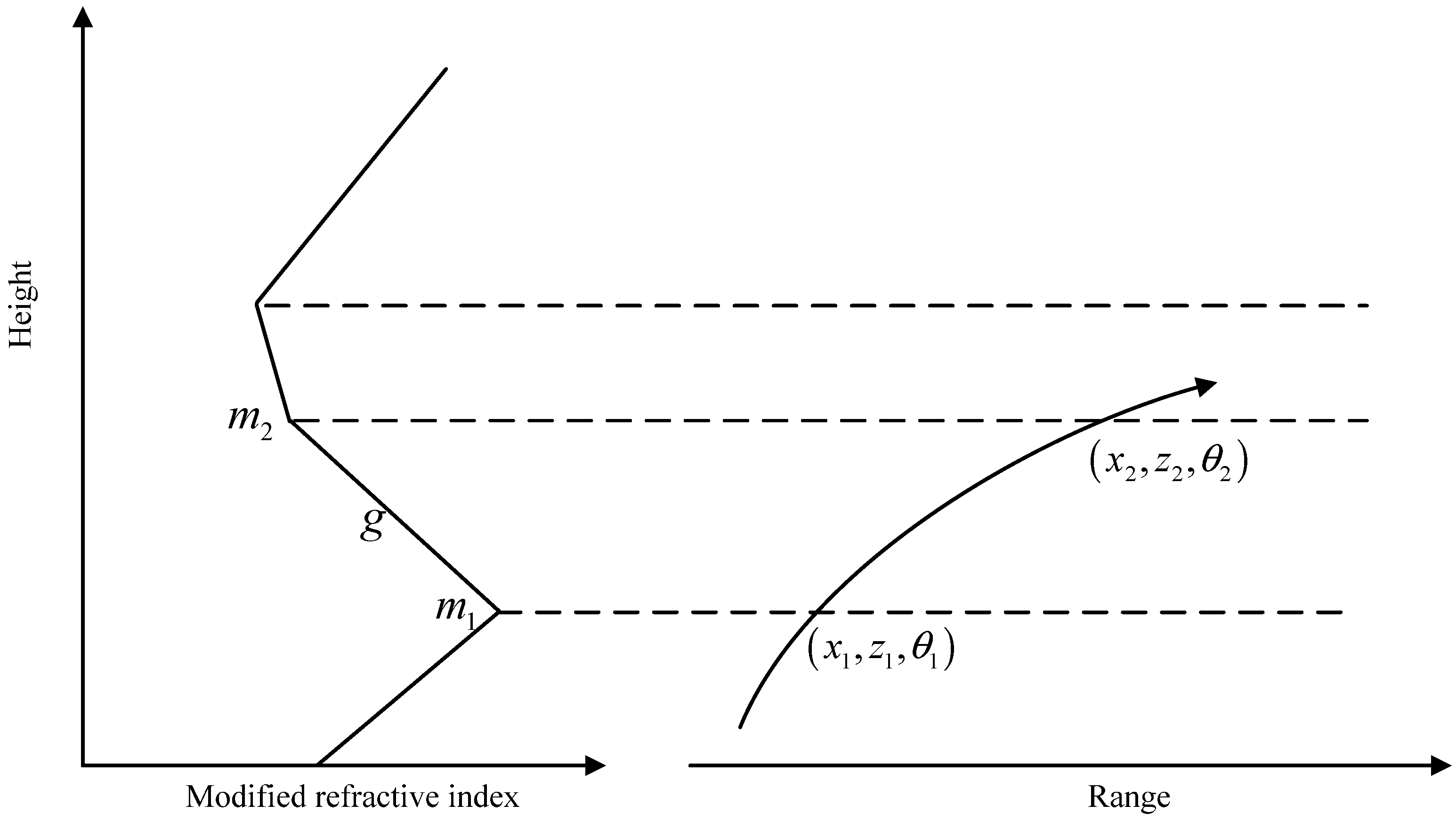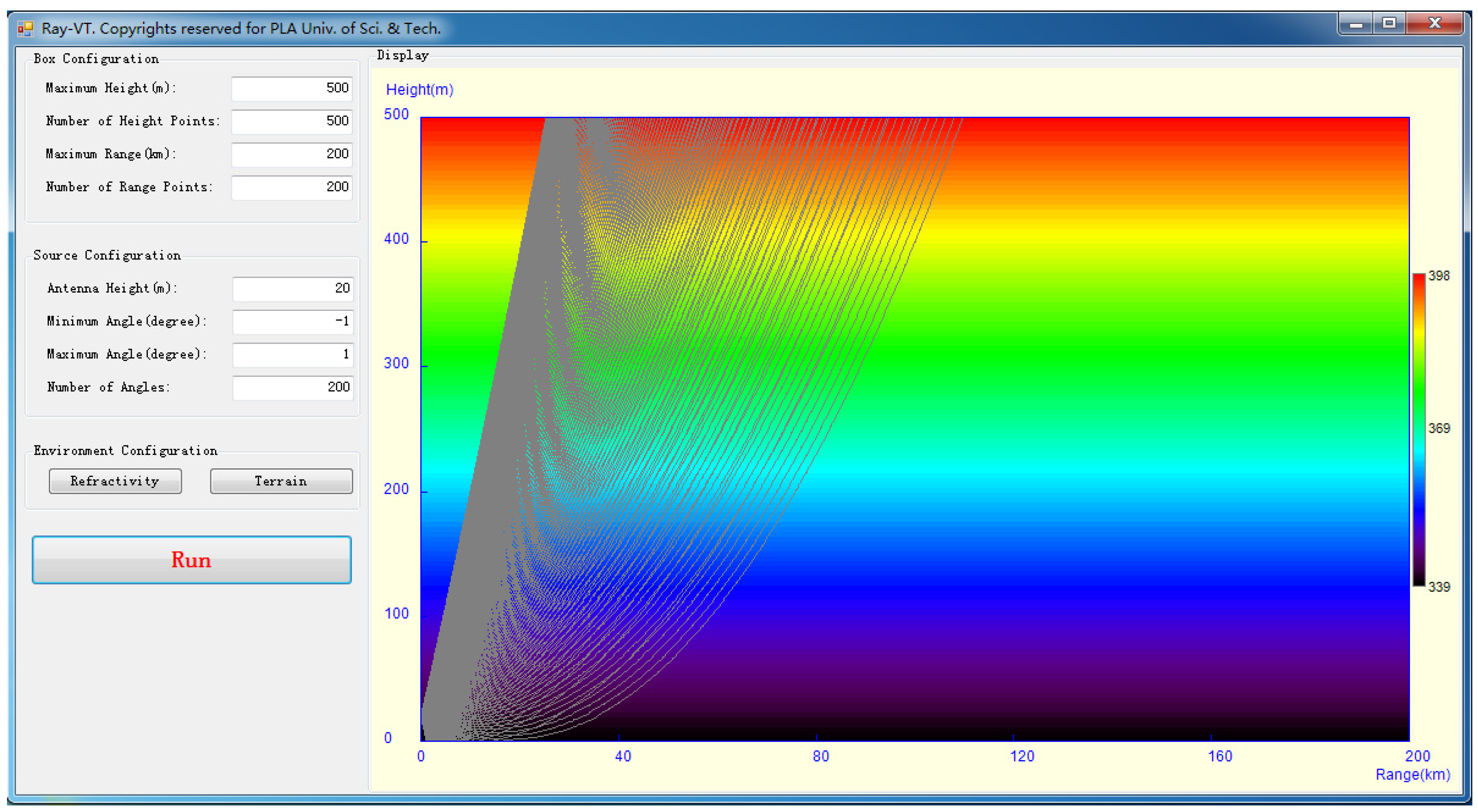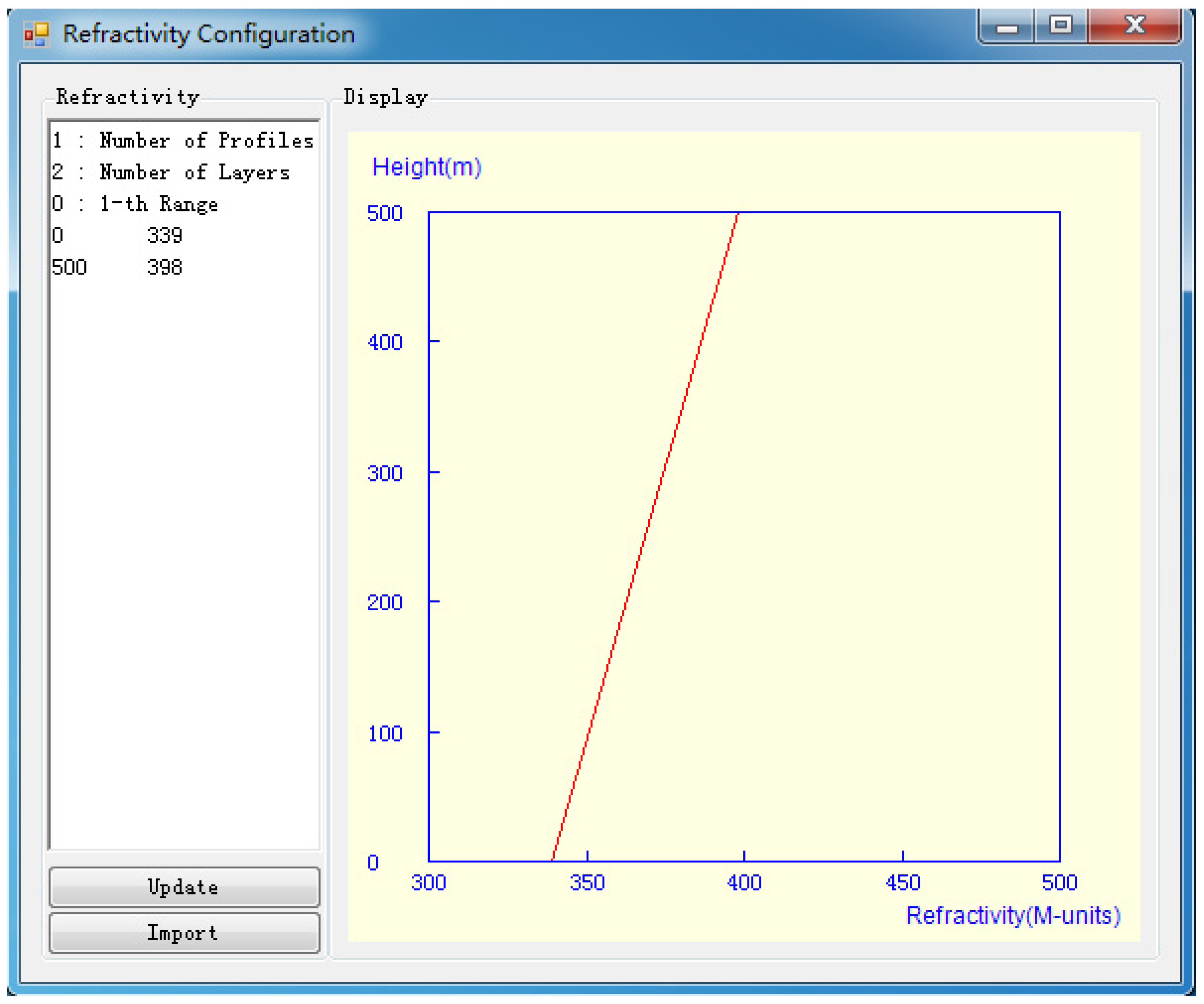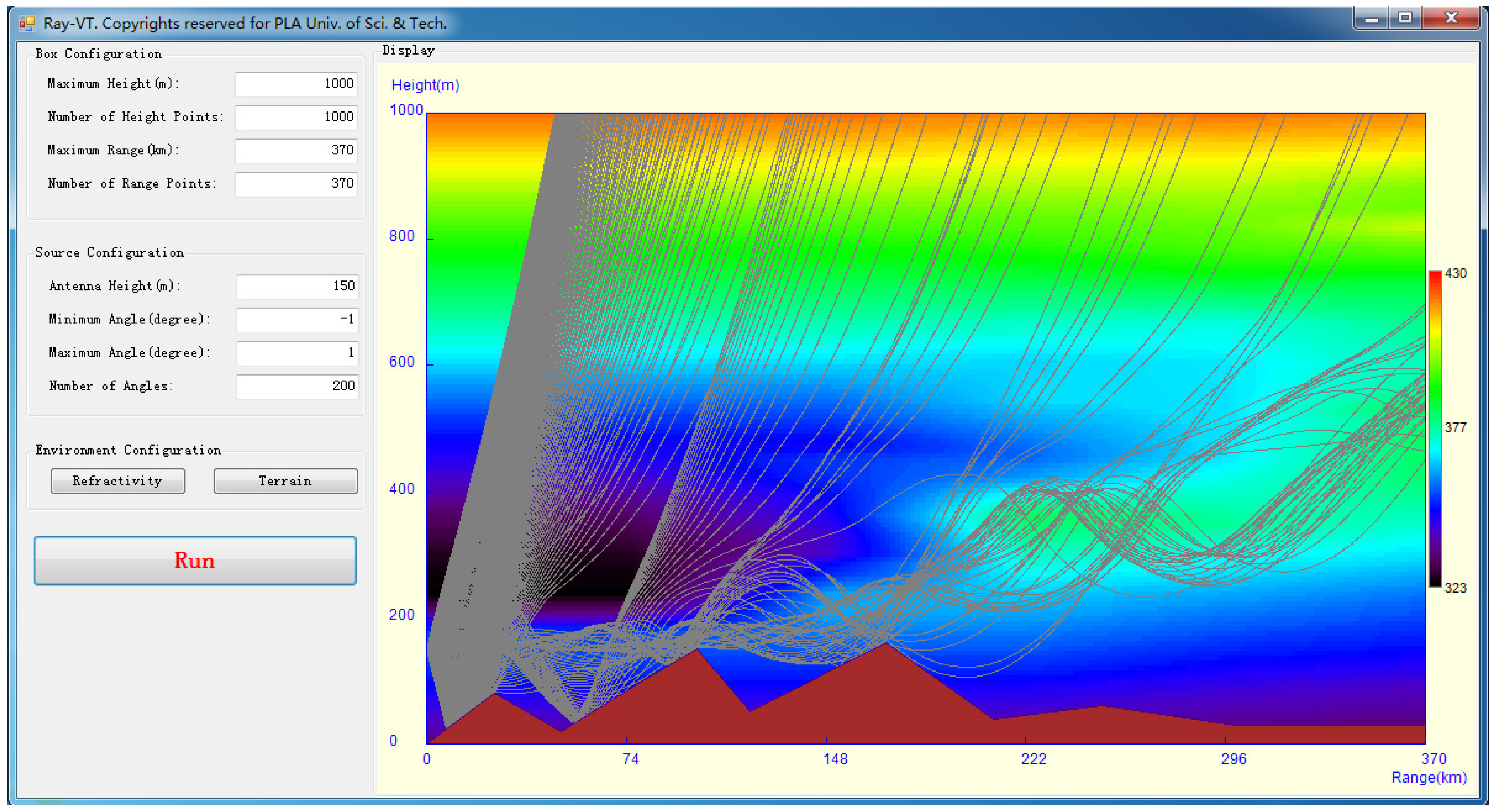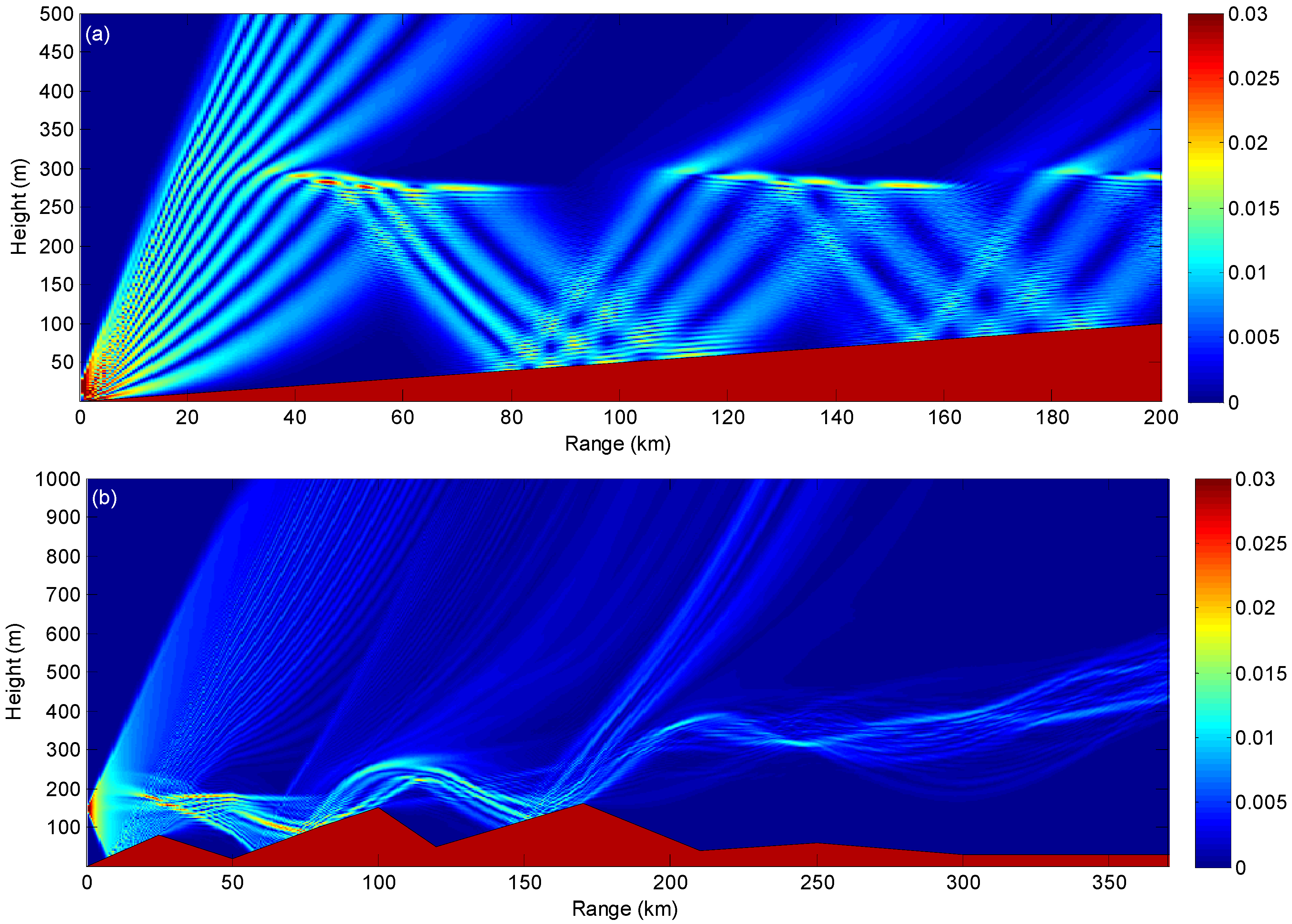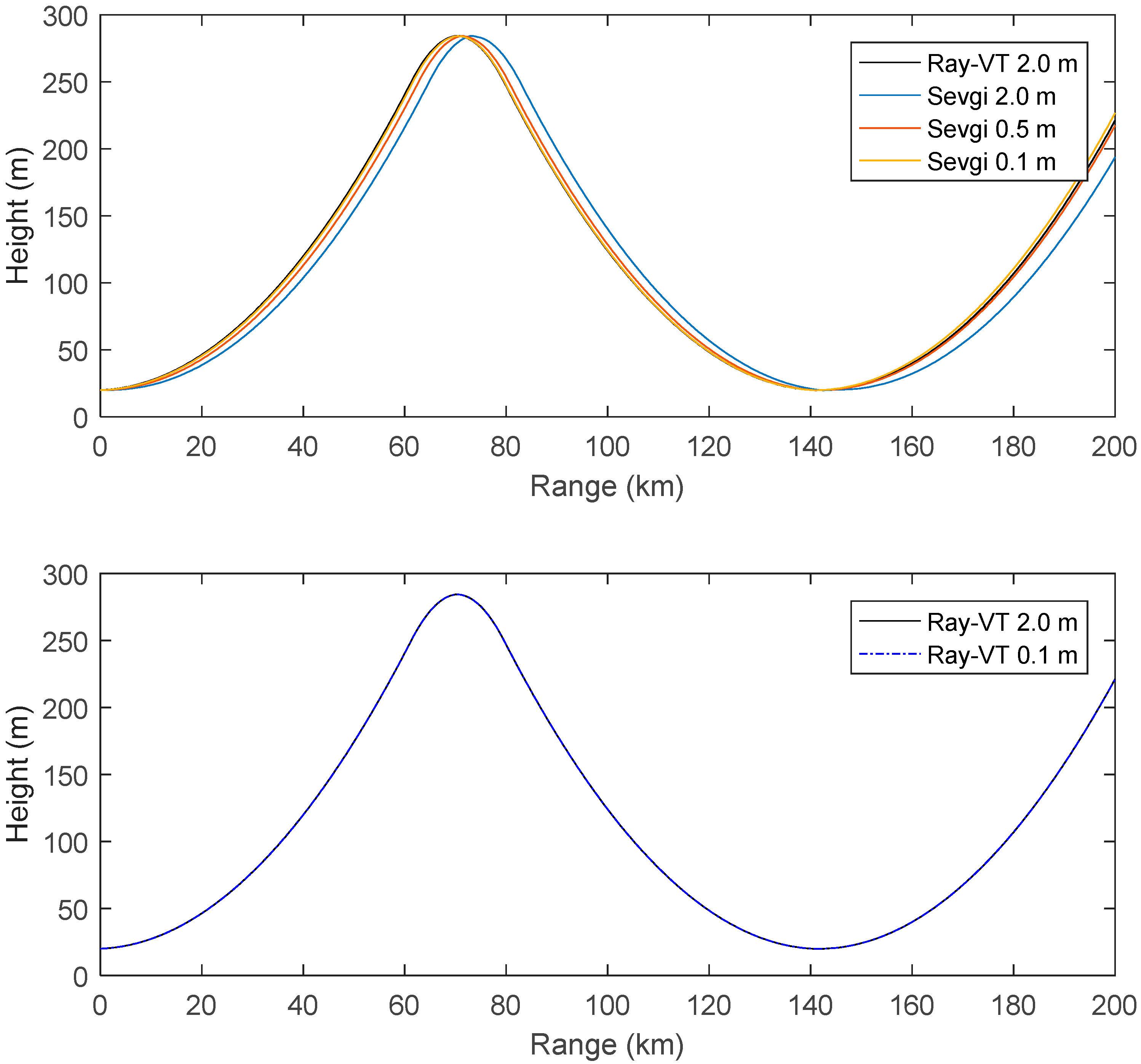1. Introduction
The guidelines for radar and other radio communication systems are usually based on standard tropospheric conditions. The atmospheric duct is a kind of non-standard refractive structure that will change the electromagnetic (EM) wave propagation paths and capture the energy to form duct propagations, leading to height and range errors of radar detections. The accurate prediction of duct propagations will help in assessing the radar’s performance. Several numerical models for tropospheric EM propagation predictions have been developed, in which the most popular methods rely on ray tracing [
1,
2,
3,
4,
5,
6,
7] and the parabolic equation (PE) [
8,
9,
10,
11]. The PE approach represents a full-wave method of a wave equation solution, while ray-tracing methods make use of the ray concept taken from geometrical optics. Although ray tracing is not capable of giving the exact field strength/phase in complex environments, it does provide a useful tool for illustrating tropospheric refraction effects, for example giving a real-time digital map of the rigorous ray trajectories between the transmitter and the receiver.
Several different ray-tracing codes have been embedded in EM propagation packages, but only a few special visual tools have been developed. A powerful tool, EOSTAR (Electro-Optical Signal Transmission and Ranging) [
5,
6], has been developed to predict the performance of electro-optical sensor systems in the marine atmospheric surface layer. However, this tool is not available for common users due to its military purpose. Sevgi et al. have exploited several MATLAB-based EM engineering programs [
11,
12,
13,
14,
15], including a PE software tool (PETOOL) [
11] and a tool for the two-dimensional visualization of ray paths [
15]. Sevgi’s ray-tracing package can only deal with range-independent refractive conditions and regular obstacles. On the other hand, the refractive index is assumed constant between adjacent vertical layers and Snell’s law is applied directly. In this method, the rays in these layers are straight lines and the direction of a ray changes discontinuously when it goes through a layer boundary. For large fixed vertical intervals, cumulative computation errors along the propagation path will be enhanced, while for small intervals, the computation time will be increased.
For tropospheric propagations, the ray positions depend much more on the gradient of refractivity than their absolute values. Dividing the propagation medium into a set of homogeneous layers and assuming the refractivity in each layer changes linearly, then the rays in these layers are the arcs of circles and the direction of a ray, when it goes through a layer boundary, changes continuously [
16]. This constant-gradient approximation method has gained wide application in the EM community, such as in the radio physical optics (RPO) propagation model [
17] and the advanced propagation model (APM) [
18]. However, in these propagation models, the ray-tracing processes are only performed for range-independent refractive environments for computing grazing angles and/or the propagation losses in the upper propagation regions.
In this paper, the constant-gradient approximation method is adopted for the development of the ray-tracing visual tool Ray-VT (PLA University of Science and Technology, Nanjing, China), which is capable of tracing ray paths through range-dependent refractive conditions as well as arbitrary terrain cases. In
Section 2, the fundamental computations of ray tracing based on a small angle approximation to the Snell’s law are presented, followed by the refractivity and terrain manipulations. The basic functions of the Ray-VT, as well as some characteristic examples, are shown in
Section 3. The accuracy of the Ray-VT is validated in
Section 4 by comparisons with the PE method. The conclusions are given in
Section 5.
3. Functions of the Ray-VT
The Ray-VT, an interactive ray-tracing visual tool, based on the technique described in
Section 2, has been developed. This tool is the first step of a ray-tracing technique, and the EM field contributions of rays are not considered. Combined with a standard refractive propagation scenario on a flat terrain, shown in
Figure 2, the front-end design of the Ray-VT is introduced. The graphical user interface (GUI) is divided into four parts: box configuration, source configuration, environment configuration and display window.
The box configuration contains the computation domain and the computation size, including the maximum height , the height points , the maximum range and the range points . Using these variables, the height bin and range bin are, respectively, determined as and . The values of these variables can be selected or changed by the user directly.
The source configuration contains the antenna height and the elevation angles. The ray paths are traced for a set of different elevation angles. The elevations are determined with the same interval , by the minimum angle , the maximum angle , and the angle numbers . These values are also selected according to the user’s requirements.
The environment configuration contains the refractivity and the terrain information, which are related to the “refractivity” and the “terrain” buttons.
Figure 3 gives the GUI of the refractivity information. The refractivity profile can be imported from a preexisting text file or specified by the user in the left textbox. The right display window shows the modified refractivity
versus the height, where
. The terrain profile can be manipulated in the same manner (not shown).
The display window in
Figure 2 shows the ray paths corresponding to a total of 200 rays emanating from a source located at a 20 m height. The maximum and the minimum elevation angles are 1° and −1°, respectively. The color contour shows the spatial variations of the refractivity with the limits given by the right colorbar. Here, the refractivity corresponds to a range-independent standard refractive environment as shown in
Figure 3.
Figure 4 gives another propagation scenario with the refractivity profile characterized by a 300 m surface-based duct with a base height of 250 m, a thickness of 50 m, and a strength of 39.5 M-units. Here, it should be noted that in the atmospheric duct environment, there exists a critical trapping angle
which is determined by the difference between the minimum modified refractive index
and the value at the antenna height
, i.e.,
. Here the critical trapping angle is 0.383°.
As can be seen in
Figure 2 and
Figure 4, the Ray-VT is an effective tool to investigate tropospheric refraction effects. In the standard atmosphere, the rays’ radius of curvature is larger than the Earth’s radius, and the rays flee away the Earth’s surface. In this case, the radar’s effective range (line-of-sight) is limited to within 30 km, while in the surface-based duct environment, most of the rays within the critical angle are trapped in the duct layer and travel over the horizon, and the radar-blind areas are also easily fixed. The ray trajectory predictions will be useful for determining the optimal positions for beyond line-of-sight communications.
Figure 5 gives the ray paths on a smooth wedge-shaped terrain for the 300 m surface-based duct environment. The bottom closed deep color shows the terrain profile. Comparing
Figure 5 with
Figure 4, along the propagation path, some captured rays are released to the upper space as a result of slope terrain reflections that change the reflection angles and make some of them go beyond the critical angle.
The above propagation scenarios are focused on range-independent refractivity, but their extension to range-dependent cases is straightforward. Owing to the fact that the spatial change of tropospheric refractivity is larger with height than with range, the horizontal homogeneity assumptions of the refractive environment in a local range are generally demonstrated to be reasonable [
22,
23]. Thus, for the range-dependent case, the refractivity can be assumed to be horizontally homogeneous in each ray-tracing step (say tens or hundreds of meters) and updated at different tracing steps.
A propagation scenario for the range-dependent refractive conditions with a much more complex terrain is shown in
Figure 6. The high resolution refractivity field, corresponding to a Pt. Loma to Guadalupe Island transect of 12 March 1948, is used [
20]. The data consist of five M-units versus height profiles, at ranges of 0, 148, 222, 296 and 370 km. Before the tracing process, the refractivity data are manipulated by the method shown in
Section 2.2. The source height for this scenario is 150 m, and 200 rays limited between −1° and 1° elevation angles are used. It is clear from the background color contour in
Figure 6 that the trapping layer increases slowly from 0 to 370 km, where the duct gradually evolves from the surface-based duct to elevated duct. Owing to the duct propagation, the rays limited to the critical angle are mainly captured in the duct layer.
4. Accuracy Validation
The Ray-VT tool is just designed to draw ray paths through a complex environment, and the EM field contributions of rays are not considered. How to use the ray-tracing method to calculate the EM field values is explained in [
24], but this method usually fails at focal points and caustics. For EM field calculations, the full-wave methods, for example the PE method, will provide more accurate results. Owing to the field strength having a strong correlation with the ray density [
25], the PE method can be used to validate the accuracy of Ray-VT indirectly. In this paper, the TPEM propagation model [
10] is used.
Figure 7 gives the coverage diagrams of the field strength computed by TPEM, where the antenna source is assumed to be omnidirectional and horizontally polarized with a frequency of 5 GHz. The environmental information in
Figure 7a,b corresponds to that in
Figure 5 and
Figure 6, respectively.
As can be seen in
Figure 7a, due to the existence of the atmospheric duct, most of the EM energy is trapped in the duct layer, and the field strength distributions are in good agreement with the ray paths shown in
Figure 5. Besides, the energy leakage above the duct at ranges of 110 km and 180 km agrees very well with the released rays at the same ranges. Perfect agreement can also be found by comparing
Figure 6 with
Figure 7b, which indicates that the Ray-VT can predict the ray paths in the complex range-dependent environment, both of refractivity and terrain, in a sophisticated manner.
Figure 8 compares the ray paths between the Ray-VT and Sevgi’s tool [
15] for surface-based duct propagation with an elevation angle of 0.01°, in which the vertical intervals for the Ray-TV were set at 2 m and 0.1 m, respectively, and the vertical intervals for Sevgi’s tool were set at 2 m, 0.5 m, and 0.1 m, respectively. It is clear seen that there are some differences in the ray trajectories of Sevgi’s tool for different vertical intervals, shown in
Figure 8a, where the height difference at the range of 200 km for 2 m and 0.1 m vertical intervals reaches 33.1 m. This phenomenon for Sevgi’s tool originates from the constant refractive index assumption between adjacent vertical layers. Although a smaller interval can obtain a more accurate result, the computation time will be increased at the same time. In the Ray-VT, the gradient of the refractive index layer is considered, which makes the ray path computation for different vertical intervals more stable, as shown in
Figure 8b where the ray paths of the Ray-VT overlap very well for the vertical intervals of 0.1 m and 2 m. In
Figure 8a, the ray path of the Ray-VT matches well with the ray path of Sevgi’s tool with a 0.1 vertical interval, and the average height difference along the propagation range is only 0.38 m. In this case, the Ray-VT just needs near one-twentieth of computation time of Sevgi’s tool.
Here, it should be noted that the validity of the small angle approximation must guarantee the shooting angle is relatively small (less than one degree). Otherwise, the error will be brought by the Taylor approximation of large angles. On the other hand, the Ray-VT uses the vertical gradient information of the refractivity. So, it should guarantee that the gradient at a fixed layer does not change.
